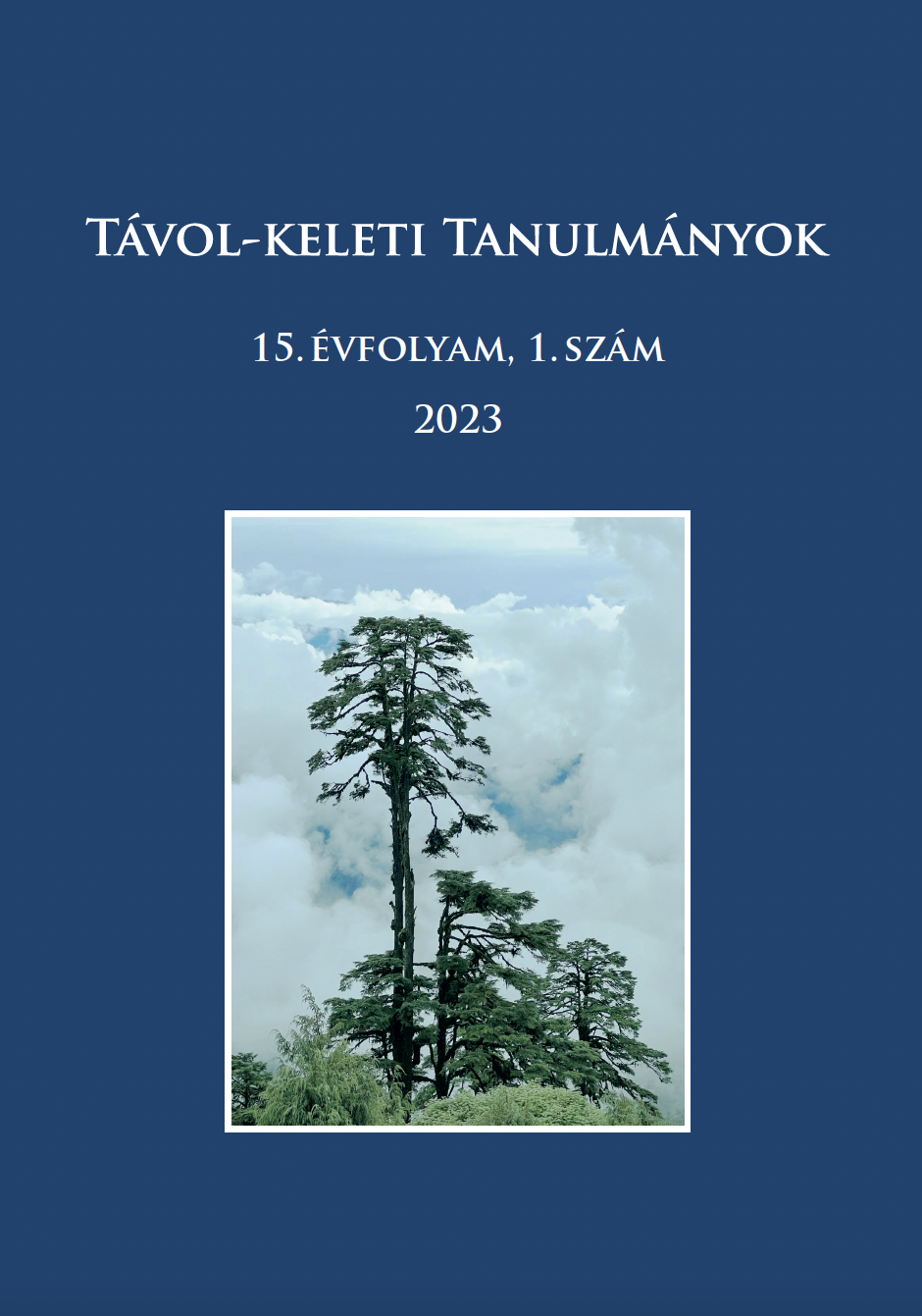Megjelent 2023-05-16
Kulcsszavak
- chan,
- Dahui Zonggao,
- gong'an,
- huatou,
- kínai buddhizmus
- Zutang ji,
- 話頭 ...Tovább
Hogyan kell idézni
Copyright (c) 2023 Mirella Keller

This work is licensed under a Creative Commons Attribution-NonCommercial 4.0 International License.
Absztrakt
A huatou 話頭 ('kulcsmondat') fogalom a chan buddhizmus egyik jellegzetes meditációs technikájára utal. A tanulmány a huatou használati és szemantikait változásait vizsgálja különböző X–XII. századi chan szövegekben.
A huatou kifejezés már az első chan gong’an 公案 (jap. kōan) gyűjteményben is előfordult, vagyis a többnyire mesterek és tanítványaik közötti interakciókat lejegyző történetek, példázatok gyűjteményében, név szerint a 952-ben összeállított Zutang ji 祖堂集 (A pátriárkák csarnokának gyűjteménye) című szöveggyűjteményben. A huatou jelentőssége Dahui Zonggao 大慧宗杲 (1089–1163) tanításainak köszönhetően változott jelentősen, szerinte ugyanis a huatou a gong’an egyesszenciális egysége, a szituáció kulcspontja, s egyben az általa tanított meditációs technika alapja.
Jelen tanulmány célja, egyfeleől, hogy a huatou kifejezés különböző szövegforrásokban való előfordulásait megvizsgálva, illetve szövegpéldák bemutatásával történeti áttekintést nyújtson a fogalom szemantikai alakulását illetően. Célja, másfelől, hogy rámutasson, a kifejezés mindig is fellelhető volt a chan gong’an irodalomban, ezzel bemutatva, hogy a Dahui Zonggao-féle meditációs technikaként való használátot a chan buddhizmusban milyen történeti fázisok előzték meg.
Hivatkozások
- Dahui pujue chanshi yulu 大慧普覺禪師語錄. T47, no. 1998A.
- Jingde chuandeng lu 景德傳燈錄 T51, no. 2076.
- Foguo Yuanwu chanshi yulu 佛果圓悟禪師語錄. T47, no. 1997.
- Tianru weizi chanshi yulu 天如惟則禪師語錄. X70, no. 1403.
- Wumen guan 無門關. T48, no. 2005.
- Xinxin ming 信心銘. T48, no. 2010.
- Zutang ji 祖堂集. B25, no. 144.
- Anderl, Christoph 2004. Studies in the Language of Zu-tang ji. Oslo: University of Oslo.
- Anderl, Christoph 2021. „Chán Buddhism in an Inter-religious and Cross-linguistic Perspective.” In: Christoph Anderl – Christian Wittern (eds.) Chán Buddhism in Dūnhuáng and Beyond. Leiden: Brill, 1–22. https://doi.org/10.1163/9789004439245_002
- Buswell, Robert 1987. “The ‘Short-cut’ Approach of K’an-hua Meditation: The Evolution of a Practical Subitism in Chinese Ch’an Buddhism.” In: Peter N. Gregory (ed.) Sudden and Gradual, Approaches to Enlightenment in Chinese Thought. Delhi: Motilal Banarsidass Publishers. https://doi.org/10.1515/9780824890773-011
- Broughton, L. Jeffrey ford. 2017. The Letters of Chan Master Dahui Pujue. Oxford: Oxford University Press.
- Cleary, Thomas és J. C. ford. 1998. The Blue Cliff Record. BDK Amerika.
- Foulk, T. Griffith 2000. “The Form and Function of Koan Literature: A Historical Overview.” The Koan: Text and contexts in Zen Buddhism. Oxford: Oxford University Press.
- Hamar Imre 1998. „A hirtelen megvilágosodás előfutára: Tao-seng.” Korunk 8: 76–80.
- Hamar Imre 2017. A kínai buddhizmus története. Budapest: ELTE Konfuciusz Intézet.
- Heine, Steven 2016. Chan Rhetoric of Uncertainty in the Blue Cliff Record, Sharpening a Sword at the Dragon Gate. USA: Oxford University Press. https://doi.org/10.1093/acprof:oso/9780199397761.001.0001
- McRae, R. John 2000. “The Antecedents of Encounter Dialogue in Chinese Ch’an Buddhism.” The Koan: Text and contexts in Zen Buddhism. Oxford: Oxford University Press, 46–74. https://doi.org/10.1525/9780520937079
- McRae, R. John 2003. Seeing Through Zen. California: University of California Press.
- Miklós Pál ford. 1987. Kapujanincs átjáró. Kínai csan-buddhista példázatok. Budapest: Helikon kiadó.
- Levering, L. Miriam. 2010. “Dahui Zonggao (1089-1163): The Image Created by His Stories about Himself and by His Teaching Style.” Zen Masters. USA: Oxford University Press, 91–116. https://doi.org/10.1093/acprof:oso/9780195367645.003.0004
- Pap Melinda. 2013. „A kínai buddhizmus története.” Buddhizmus. Budapest: Magyar Vallástudományi Társaság, L’Harmattan, 175–194.
- Poceski, Mario 2015. The Records of Mazu and the Making of Classical Chan Literature. Oxford: Oxford University Press. https://doi.org/10.1093/acprof:oso/9780190225742.001.0001
- Sekida Satsuki 1997. Two Zen Classics. New York: Weatherhill.
- Sharf, Robert H. 2005. Coming to Terms with Chinese Buddhism: A Reading of the Treasure Store Treatise. Honolulu: University of Hawai’i Press,
- Sharf, Robert H. 2007. “How to Think with Chan Gong’an.” Thinking with cases, Specialist Knowledge in Chinese Cultural History. Honolulu: University of Hawai’i Press, 205–243.
- Schlütter, Morten 2000. “Before the Empty Eon’ versus ‘A Dog Has No Buddha-Nature’, Kung-an Use in the Ts’ao-tung Tradition and Tahui’s Kung-an Introspection Ch’an.” The Koan: Text and contexts in Zen Buddhism. Oxford: Oxford University Press, 168–199.
- Schlütter, Morten 2010. How Zen became Zen, The dispute over Enlightenment and the Formation of Chan Buddhism in Song-Dynasty China. Honolulu: University of Hawai’i Press.
- Sun, Chaofen 1996. Word-Order Change and Grammaticalization in the History of Chinese. Standford: Standford University Press.
- Terebess Gábor ford. 1990. Folyik a híd, Zen/csan buddhista anekdotakincs. Budapest: Officina Nova.
- Wu, Jiang 2008. Enlightenment in Dispute. New York: Oxford University Press.
- Yü Chün-fang 1979. “Ta-hui Tsung-kao and Kun-an Ch’an.” Journal of Chinese Philosophy 6: 211–235. https://doi.org/10.1111/j.1540-6253.1979.tb00084.x

